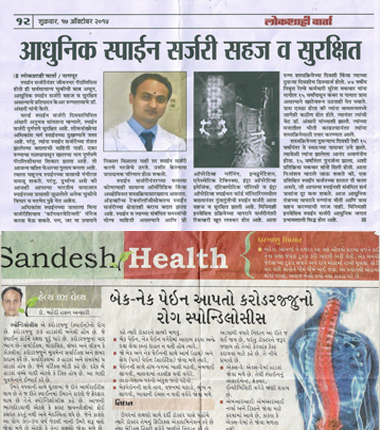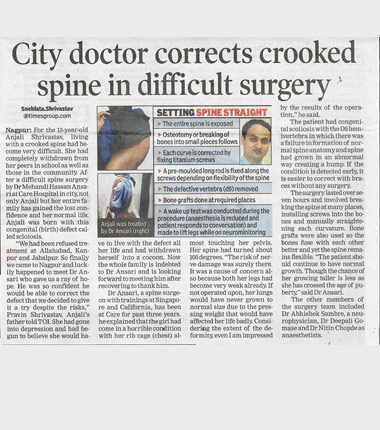+971 4267 9999 FAX +971 267 8889
Welcome to Dr. Ansari's
Spinal Disease Information Guide !!
Back and neck pain is one of the most common complaint that a patient presents to a doctor with. A wide variety of conditions can result in Back and Neck pain, whilst most heal with time with home remedies, analgesics and physical therapy, some require immediate medical attention. A proper diagnosis of back pain goes a long way in managing pain, preventing complications, circumventing chronic pain and getting back to active healthy life. The page attempts to serve as a source of information to equip patients with the basic knowledge of Spine and Spinal pain. However, it can never substitute a personal, physician consultation of your choice and formulation of proper management plan based on thorough history, clinical examination and relevant investigations.

The spinal column is one of the most vital parts of the human body, supporting our trunks and making all of our movements possible. Its anatomy is extremely well designed, and serves many functions, including:
- Movement
- Balance
- Upright posture
- Spinal cord protection
- Shock absorption
All of the elements of the spinal column and vertebrae serve the purpose of protecting the spinal cord, which provides communication to the brain and mobility and sensation in the body through the complex interaction of bones, ligaments and muscle structures of the back and the nerves that surround it. The normal adult spine is balanced over the pelvis, requiring minimal workload on the muscles to maintain an upright posture. Loss of spinal balance can result in strain to the spinal muscles and spinal deformity. When the spine is injured and its function impaired, the consequences may be painful and even disabling.
read more --
Back Pain, neck pain and symptoms caused by a spinal condition are a common problem for many adult Americans. The different parts of the spine are normally well balanced and able to handle the movements, stresses, and strains of the body gracefully. However, when parts of the neck or back are injured or start to wear out, it can be a significant source of pain and discomfort. When describing symptoms to your doctor use adjectives like dull, aching, hot, or throbbing and make sure to include the duration of these symptoms. Below are some common symptoms. To learn more, click on the symptom that you have been experiencing:
If any of the following symptoms occur, contact a doctor immediately:
- Pain is worse when you cough or sneeze
- Pain or numbness travels down one or both legs
- Pain awakens you from sleep
- You are finding it difficult to pass urine or have a bowel movement
- Pain is accompanied by loss of control of urination or bowel movements
These important symptoms could signal nerve damage or other serious medical problems. There are many other conditions that could be causing these problems, but an early and accurate diagnosis is vital for successful treatment.

What's causing my back or neck pain? It's a common question, and a visit to your doctor is an important first step to get an answer. You should know that the diagnosis of back, neck, leg or arm pain isn't always easy. The human spine is very complex, so it can be difficult for your doctor to pinpoint the exact cause of low back pain or other symptoms. Below are some common spinal conditions. Learn more by clicking on a diagnosis:
- Degenerative Disc Disease (DDD)
- Herniated Disc
- Osteoporosis
- Spondylolisthesis
- Stenosis
- Spinal Fractures
The history of the pain and any activities that may have triggered your symptoms are important factors in diagnosis and treatment.


In addition to regular cardiovascular exercise, the American Academy of Orthopaedic Surgeons has also recommended a series of exercises that have been specifically chosen in order to help strengthen and condition the muscles that support the spinal column. These exercises can be done at home, and they do not require any special exercise equipment. The primary goals of an exercise program for your spine are to make the muscles of your back, stomach, hips and thighs strong and flexible. These exercises should be incorporated into an overall program of aerobic conditioning such as walking, bike riding, swimming, or jogging. Before beginning any exercise program, check with your doctor to make sure that there are no other medical considerations that would change your approach to the exercise program. If exercise is new to you, then consider working with a certified personal trainer who can help you develop an exercise program that will meet your goals. Low Back Exercise Guide: Regular exercises to restore the strength of your back and a gradual return to everyday activities are important for your full recovery. Your orthopaedic surgeon and physical therapist may recommend that you exercise 10 to 30 minutes a day one to three times a day during your early recovery. They may suggest some of the following exercises. This guide can help you better understand your exercise and activity program, supervised by your therapist and orthopaedic surgeon.











